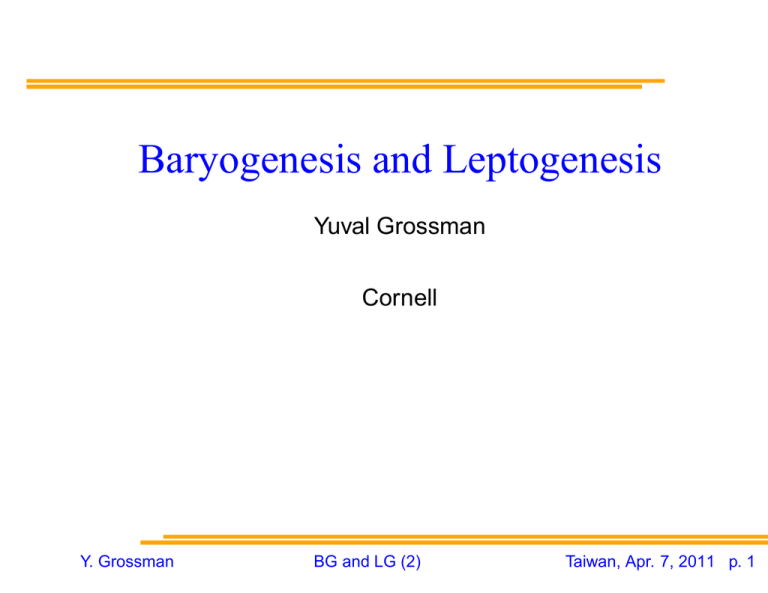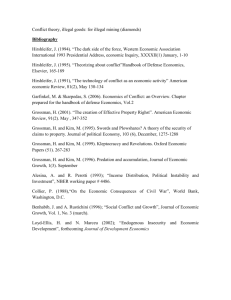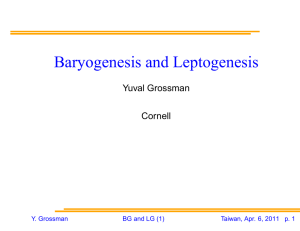Baryogenesis and Leptogenesis Yuval Grossman Cornell Y. Grossman
advertisement

Baryogenesis and Leptogenesis Yuval Grossman Cornell Y. Grossman BG and LG (2) Taiwan, Apr. 7, 2011 p. 1 Last time Last time The question: Why n(B) ≪ n(B) and η ∼ 10−10 Answer: Baryogenesis and the Sakharov’s conditions Model buildings Today: The SM, CPV and start of model for BG Y. Grossman BG and LG (2) Taiwan, Apr. 7, 2011 p. 2 Basics of model building Axioms of physics L=? 1. Gauge symmetry 2. representations of the fermions and scalars (irreps) 3. SSB (relations between parameters) Then L is the most general renormalizable one Y. Grossman BG and LG (2) Taiwan, Apr. 7, 2011 p. 3 Renormalzabilty and all that Y. Grossman BG and LG (2) Taiwan, Apr. 7, 2011 p. 4 What is a renormalizable field theory? Please write it down! Y. Grossman BG and LG (2) Taiwan, Apr. 7, 2011 p. 5 What is a renormalizable field theory? Please write it down! No operators with negative dimensions couplings mψ̄ψ Yh H ψ̄ψ G(ψ̄γµ ψ)(ψ̄γ µ ψ) But what is the physics? Y. Grossman BG and LG (2) Taiwan, Apr. 7, 2011 p. 5 IR, UV and renormalizability The dimension tells us when an operator is important Consider standard dispersion relation E 2 = p 2 + m2 At the IR, low energy, E ≈ m At the UV, high energy, E ≈ p What if 4 p E 2 = m2 + p 2 + 2 ? Λ Y. Grossman BG and LG (2) Taiwan, Apr. 7, 2011 p. 6 IR, UV and renormalizability The dimension tells us when an operator is important Consider standard dispersion relation E 2 = p 2 + m2 At the IR, low energy, E ≈ m At the UV, high energy, E ≈ p What if 4 p E 2 = m2 + p 2 + 2 ? Λ It is all about Λ For p ≪ Λ the last term in not important For p ≫ Λ the last term is important Y. Grossman BG and LG (2) Taiwan, Apr. 7, 2011 p. 6 MDR: Modified Dispersion Relation 4 p E 2 = m2 + p 2 + 2 Λ Is the MDR Lorentz invariance? Is the MDR excluded experimentally? What can we say about Λ? Y. Grossman BG and LG (2) Taiwan, Apr. 7, 2011 p. 7 MDR: Modified Dispersion Relation 4 p E 2 = m2 + p 2 + 2 Λ Is the MDR Lorentz invariance? Is the MDR excluded experimentally? What can we say about Λ? All we can say is that experimentally Λ is large compare to any scale we probed This is not the same as saying that we know Λ → ∞. We set Λ → ∞ since we deal with “low energy” Y. Grossman BG and LG (2) Taiwan, Apr. 7, 2011 p. 7 Back to QFT NR terms just refer to terms that are important at the UV When we construct a theory, at first we set all the NR terms to zero since we care about low energy At later stages, when we care about small corrections at “low” energies, we may add them Important: We are modest! We do not try to explain physics at energies we cannot probe The issue of mathematical consistency is just the above statement. It is inconsistent to use NR theories to explain physics at very high scale. Y. Grossman BG and LG (2) Taiwan, Apr. 7, 2011 p. 8 Global and Accidental symmetries We only impose gauge (or local) symmetries Well, they are nicer (think about it...) There is an argument that quantum gravity always break them (so what?) We like to think that all global symmetries are accidental. They are there just because the field choices and the requirement of renormalizability Global symmetries can be there at the “classical” level but be broken at the quantum level (anomalies) We think all symmetries are either local or broken! Y. Grossman BG and LG (2) Taiwan, Apr. 7, 2011 p. 9 Lepton and baryon numbers The SM has a U (1)B × U (1)e × U (1)µ × U (1)τ global symmetry Only leptons carry L and only quarks carry B All processes observed so far conserve L and B Processes that violate it, like P + → e+ γ , were not observed Baryon and lepton number are accidental symmetries of the SM B+L is broken by an anomaly B and L are broken by NR operators. Can you think of such operators? Y. Grossman BG and LG (2) Taiwan, Apr. 7, 2011 p. 10 Discrete space time symmetries C, P, and T Any Local Lorentz invariant QFT conserves CPT No theoretical reason for C, P or T to be conserved separately In the SM the weak interaction breaks them all. This is also what we see in Nature. Any chiral theory break C and P The condition for CP violation is more complicated: a phase in L Y. Grossman BG and LG (2) Taiwan, Apr. 7, 2011 p. 11 The SM Y. Grossman BG and LG (2) Taiwan, Apr. 7, 2011 p. 12 Basics of model building Axioms of physics L=? 1. Gauge symmetry 2. representations of the fermions and scalars (irreps) 3. SSB (relations between parameters) Then L is the most general renormalizable one Y. Grossman BG and LG (2) Taiwan, Apr. 7, 2011 p. 13 A working example: the SM Symmetry: SU (3)C × SU (2)L × U (1)Y irreps: 3 copies of QUDLE fermions QL (3, 2)1/6 LL (1, 2)−1/2 UR (3, 1)2/3 ER (1, 1)−1 SSB: one scalar with negative µ2 φ(1, 2)+1/2 hφi = ⇒ Y. Grossman DR (3, 1)−1/3 0√ v/ 2 SU (2)L × U (1)Y → U (1)EM BG and LG (2) Taiwan, Apr. 7, 2011 p. 14 Then Nature is given by... the most general L L = Lkin + LHiggs + LY ukawa Kinetic terms give rise to the gauge interactions The Gauge interactions are universal (better emphasis that!) 3 parameters, g , g ′ and gs In the SM only LH fields participate in the weak interaction The Higgs part gives the vev and the Higgs mass. 2 parameters Yukawa terms: H ψ̄L ψR . This is where flavor is. 13 parameters, one phase that lead to CPV Y. Grossman BG and LG (2) Taiwan, Apr. 7, 2011 p. 15 Quarks YijD Q̄L i φ (DR )j + YijU Q̄L i φ̃ (UR )j The Yukawa matrix, YijF , is a general complex matrix After the Higgs acquires a vev, the Yukawa terms give masses to the fermions. Also, after the breaking we can talk about UL and DL , not about QL If Y is not diagonal, flavor is not conserved If Y carries a phase, CP is violated. C and P are violated to start with Y. Grossman BG and LG (2) Taiwan, Apr. 7, 2011 p. 16 The CKM matrix It is all about moving between bases... We can diagonalize the Yukawa matrices Ydiag = VL Y VR† , VL , VR are unitary The mass basis is defined as the one with Y diagonal, and this is when (dL )i → (VL )ij (dL )j , (dR )i → (VR )ij (dR )j The couplings to the photon is not modifies by this rotation Lγ ∼ d¯i δij di → d¯i V δij V † d ∼ d¯i δij di Y. Grossman BG and LG (2) Taiwan, Apr. 7, 2011 p. 17 CKM, W couplings For the W the rotation to the mass basis is important LW ∼ ūiL δij diL → ūi VLU δij VLD† d ∼ ūi VCKM di where VCKM = VLU VLD† The point is that we cannot have YU , YD and the couplings to the W diagonal at the same basis In the mass basis the W interaction change flavor, that is flavor is not conserved The CKM matrix is very close to a unit matrix. Off diagonal terms are very small Y. Grossman BG and LG (2) Taiwan, Apr. 7, 2011 p. 18 CPV Y. Grossman BG and LG (2) Taiwan, Apr. 7, 2011 p. 19 What is CP A symmetry between a particle and its anti-particle CP is violated if we have Γ(A → B) 6= Γ(Ā → B̄) It is not easy to detect CPV Always need interference of two (or more) diagrams CPT implies that total width are the same, so we need at least two modes with CPV To see CPV we need 2 amplitudes with different of both weak and strong phase Y. Grossman BG and LG (2) Taiwan, Apr. 7, 2011 p. 20 CP violation A simple “hand wave” argument of why CP violation is given by a phase It is all in the +h.c. term † ∗ Yij Q̄L i φ (DR )j + Yji D̄R j φ (QL )i Under CP Yij D̄R † j φ (QL )i + CP is conserved if Yij = Yji∗ Yji∗ Q̄L j φ (DR )i Not a full proof, since there is still a basis choice... Y. Grossman BG and LG (2) Taiwan, Apr. 7, 2011 p. 21 All these phases Weak phase (CP-odd phase). Change sign under CP CP (Aeiφ ) = Ae−iφ Phase in L L ∝ Vub ū b W + + h.c. ∗ ū b W + + h.c. CP (L) ∝ Vub In the SM the CP odd phases arise only in the weak part so they are called weak phases In the SM all these phases are related to the one physical phase, δKM Y. Grossman BG and LG (2) Taiwan, Apr. 7, 2011 p. 22 All these phases: Strong phases Strong phase (CP-even phase). Do not change under CP CP (Aeiδ ) = Aeiδ Due to time evolution ψ(t) = e−iHt ψ(0) They are also due to intermediate real states. When we have strong interactions, these phases have to do with “rescattering” of hadrons Such strong phases are very hard to calculate Y. Grossman BG and LG (2) Taiwan, Apr. 7, 2011 p. 23 Why we need the two phases? Intuitive argument If we have only one amplitude |A|2 = |Ā|2 Two but only with a different of weak phase 2 2 iφ −iφ A + be = A + be When both are not zero it is not the same (do it for HW!) 2 2 i(δ−φ) i(δ+φ) A + be − A + be = 4Ab sin δ sin φ Y. Grossman BG and LG (2) Taiwan, Apr. 7, 2011 p. 24 Some summary Model building is based on axioms: Gauge symmetries, field content and SSB The Lagrangian is the most general renormalizable one Renormalizability is really the point that we don’t try to explain physics at very short distance Now that we have the Lagrangian, what can we do with it? Measure its parameters Make predictions and test them Y. Grossman BG and LG (2) Taiwan, Apr. 7, 2011 p. 25 Back to Baryogenesis Y. Grossman BG and LG (2) Taiwan, Apr. 7, 2011 p. 26 Baryogenesis in the SM? Based on what we talked The SM has C violation (like any chiral model) There is CP violation. It is, however, in the flavor sector and requires 3 generations Baryon number is an accidental symmetry Did not even talk about the out of equilibrium condition We will show later that one can have BG in the SM, but it is not “simple” Y. Grossman BG and LG (2) Taiwan, Apr. 7, 2011 p. 27 Total asymmetry Consider decays of particle X that generate baryons η = NI ǫ η a NI is the initial density of X at T ≫ mX # × ζ(3) NI = g∗ ǫ < 1 is the CP violation asymmetry ηa < 1 is an efficiency factor due to “washout” effects Y. Grossman BG and LG (2) Taiwan, Apr. 7, 2011 p. 28 Heavy particle decays What is needed for X decays to generate Baryon asymmetry? X can decay in a Baryon number violating way CP violation from interference between tree and loop diagrams Strong phase arises when the loop diagram internal fields on-shell The decay is when the heavy particle is out of equilibrium (roughly when T < M ) GUT baryogenesis is an example of such a scenario Y. Grossman BG and LG (2) Taiwan, Apr. 7, 2011 p. 29







